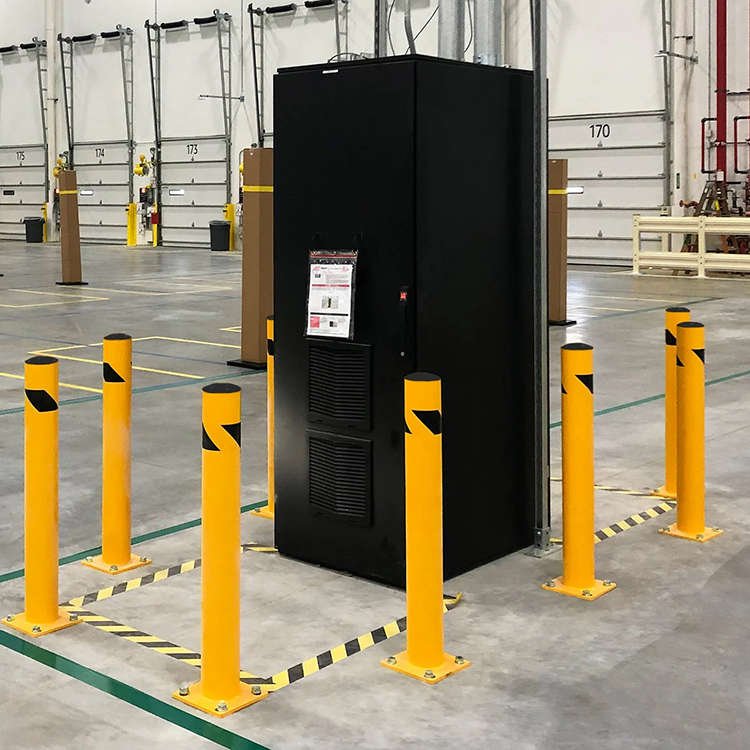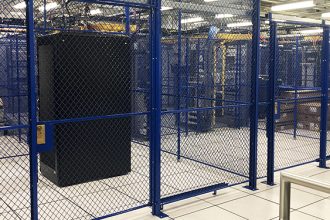How To Select The Right Bollard Material For Your Application

Bollards are vertical posts anchored to a concrete surface to create a protective barrier that absorbs and dissipates impact energy. Their placement creates a physical obstruction between personnel and moving hazards, such as materials handling equipment or vehicles, without impeding employee movement. Bollards also protect inventory, structures, or assets against potential impacts from forklifts and their loads. To ensure this type of protective guarding will improve safety inside distribution centers, warehouses, and manufacturing facilities—or outside in parking lots—it’s important to know how to select the right bollard material for your application.
“Bollards come in three primary materials,” explained Tom Ustach, Chief Innovation Officer at McCue Corporation, a member of the Protective Guarding Manufacturers Association (ProGMA). “These are polymer, rubber, or steel. Some manufacturers also use a combination of those three materials as part of a bollard’s construction.”

Bollard Material Characteristics
The rubber or polymer used in bollards is elastic and flexible, explained Ustach.
“When a vehicle or other object collides with a rubber or polymer bollard, the bollard compresses and deforms to absorb the kinetic energy of the impact,” he said. “Because they are shock absorbing materials, they can deform without breaking, then bounce back to their original shape.”
Some rubber or polymer bollards are built around a core material, such as steel, that may be embedded into the ground. This reinforcement enhances both the strength and stability of the bollard. It also prevents it from movement as a result of an impact.
A steel bollard stops an impact in a similar way to a rubber or polymer bollard, but with different material properties. When a vehicle collides with a steel bollard, the protective device does not deform in the same way that a rubber or polymer bollard would. Instead, the steel bollard resists the collision through its strength and rigidity, transferring kinetic energy into the ground to dissipate the impact forces.
To figure out which bollard material is the best choice for a given protective guarding application, the members of ProGMA recommend answering three key questions. They include:
1. What is the bollard’s purpose?
Understanding what the objective for the protective guarding device will help to pinpoint the optimal bollard material, said Ustach.
“Some bollard designs are lightweight, such as those used to segregate or delineate travel routes but don’t stop movement,” he explained. “In these cases, a polymer bollard might be adequate.”
Other bollards protect personnel, facility structures, products, or equipment from potential vehicle impacts. “Those need to be strong enough to withstand the forces of a moving forklift, truck, or car,” Ustach continued. “The strength and durability required for that application would likely call for high-strength steel with a core embedded into the ground.”

2. How much free space is in the protected area?
The available space in the area requiring protection also influences bollard material selection. If there’s a lot of open space around the bollard, it won’t damage anything if it topples over when absorbing an impact. In those instances, a less rigid material—such as polymer or rubber—may be sufficient.
Conversely, if the guarding device is protecting a sensitive piece of equipment or an outdoor seating area next to a parking lot, the bollard material must have minimal deflection characteristics in order to resist the impact. For these types of applications, steel bollards are often the safest choice.

3. What types of vehicles are operating in the area?
Designing and specifying bollard material to protect against impacts from indoor industrial vehicles is often more straightforward than outdoor applications, Ustach noted.
“Inside a facility, you generally know what types of forklifts are in use. Information about their maximum vehicle and load weight, top travel speeds, traffic patterns and areas in which they’ll be operating is fairly consistent,” he explained. “If it’s likely to only be a glancing blow or a low-speed collision, a flexible bollard material such as rubber or polymer might be ideal. Those materials, because of their flexibility, also provide some cushioning which reduces the risk of injury to the forklift operator.”
Outside a facility in a parking lot, however, a bollard’s design and material must account for a broad range of different vehicle types. That includes cars, tractor-trailers, motorcycles, box trucks, and more.
“Each of those vehicles has vastly different bumper heights, as well as weights and speeds,” Ustach said. “In these situations, it’s safest to choose a bollard material and design that can endure a high degree of impact force at any height. That would almost always mean a steel bollard.”

Looking for more information about bollards and other protective guarding solutions for inside and outside your facility? The members of the Protective Guarding Manufacturers Association (ProGMA) are available for guidance and recommendations.



